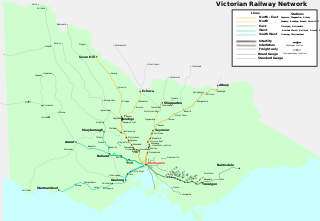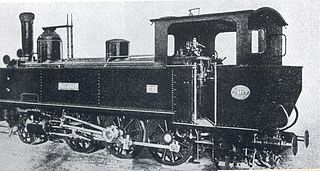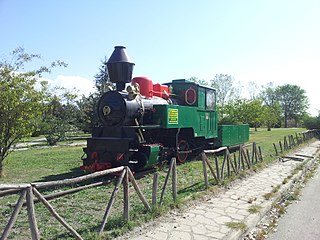
The Australian state of New South Wales has an extensive network of railways, which were integral to the growth and development of the state. The vast majority of railway lines were government built and operated, but there were also several private railways, some of which operate to this day.

Rail transport in the Australian state of Victoria is provided by a number of railway operators who operate over the government-owned railway lines. The network consists of 2,357 km of Victorian broad gauge lines, and 1,912 km of standard gauge freight and interstate lines; the latter increasing with gauge conversion of the former. Historically, a few experimental 762 mm gauge lines were built, along with various private logging, mining and industrial railways. The rail network radiates from the state capital, Melbourne, with main interstate links to Sydney and to Adelaide, as well as major lines running to regional centres, upgraded as part of the Regional Fast Rail project.

The Hellenic Railways Organisation or OSE is the Greek national railway company which owns, maintains and operates all railway infrastructure in Greece with the exception of Athens' rapid transit lines. Train services on these lines are run by Hellenic Train S.A., a former OSE subsidiary, Rail Cargo Logistics Goldair, Pearl and Grup Feroviar Român.

The Athens–Piraeus Electric Railways, commonly abbreviated as ISAP, was a company which operated the Piraeus - Kifissia line from 1 January 1976 to 17 June 2011. Piraeus - Kifissia line was the oldest urban rapid transit system of Athens metropolitan area. The line opened in 1869 as a suburban railway line connecting Athens with its port of Piraeus and it was gradually converted to full rapid transit operations, making it one of the oldest metro lines in the world. The line which ISAP S.A. operated evolved from the older Athens & Piraeus Railway and Lavrion Square-Strofyli railway.

Hellenic State Railways or SEK was a Greek public sector entity which was established on 18 March 1920 by the law 2144/20 and operated most Greek railway lines until 1970.

The Diakopto–Kalavryta railway is a historic 750 mm gauge rack railway in Greece. Located on the northern Peloponnese, it runs 22 kilometres (14 mi) from Diakopto through the Vouraikos Gorge and the old Mega Spilaion Monastery and up to Kalavryta, stopping en route at Zachlorou. Today, the stations infrastructure and rolling stock are owned and maintained by the GAIAOSE and the line infrastructure Hellenic Railways Organisation (OSE) and passenger trains are operated by Hellenic Train. At the Diakopto terminus, the line connects with the new standard-gauge Athens Airport–Patras railway; as of 2019 the new track is in place in a cutting through the station yard.

Railways in Western Australia were developed in the 19th century both by the Government of Western Australia and a number of private companies. Today passenger rail services are controlled by the Public Transport Authority through Transperth, which operates public transport in Perth, and Transwa, which operates country passenger services. Journey Beyond operates the Indian Pacific.

Piraeus is the name of two railway stations in Piraeus, Athens, Greece, approximately 9 km south-west of the centre of Athens. The southern building is an interchange station between Line 1 and Line 3 and is the present terminus of Athens Metro Line 1, formerly the Athens-Piraeus Railways Co that opened in 1869. The northern building is the railway terminus for standard gauge railway services of the Athens Suburban Railway to the Acharnes Railway Center and Chalcis. Both buildings are located next to the seaport, with the Electric Railways Museum of Piraeus located in the metro station, in the space of the former Post Office.

Rail transport in Greece has a history which began in 1869, with the completion of the then Athens & Piraeus Railway. From the 1880s to the 1920s, the majority of the network was built, reaching its heyday in 1940. From the 1950s onward, the railway system entered a period of decline, culminating in the service cuts of 2011. Ever since the 1990s, the network has been steadily modernized, but still remains smaller than its peak length. The operation of the Greek railway network is split between the Hellenic Railways Organisation (OSE), which owns and maintains the rail infrastructure; GAIAOSE, which owns the building infrastructure and the former OSE rolling stock, Hellenic Train; and other private companies that run the trains on the network. Greece is a member of the International Union of Railways (UIC). The UIC Country Code for Greece is 73.

Piraeus, Athens and Peloponnese Railways or SPAP was a Greek railway company founded in 1882 as a private company, owning and operating the 1,000 mm Piraeus–Patras railway line connecting Piraeus and Athens to Peloponnese. The company was nationalized in 1954 and formally absorbed by the Hellenic State Railways in 1962.

Athens–Lavrion Railway was a 1,000 mmmetre gauge railway line connecting downtown Athens with Eastern Attica and the mining town of Lavrion in Greece.

Thessaly Railways was a private railway company in Greece, which owned and operated the metre gauge railway network of Thessaly and Pelion railway from 1884 to 1955, when the private company was absorbed by the Hellenic State Railways state-owned company. Today the term usually refers to the section of mainline between Domokos and Rapsani and its two branches, the West Thessaly branch to Kalambaka and the Volos branch.

Rail transport in Togo consists of 568 km (353 mi) (2014) of 1,000 mmmetre gauge railway.

Pelion railway is a 600 mm narrow gauge railway line of Thessaly Railways private-owned company in Greece, connecting the city of Volos with the town of Mileai on Pelion.
The Piraeus-Perama light railway was a standard gauge suburban light railway line in Greece which connected Piraeus with Perama and Salamis Naval Base. The line was owned by the Hellenic Electric Railways private company and operated from 1936 to 1977.

Dekeleia railway station is a station on the Piraeus–Platy railway line in the northern part of the Athens metropolitan area, in the municipality of Acharnes, East Attica, Greece. It was inaugurated on 8 March 1904 and reopened on 6 May 2005. It is owned by OSE, but service are provided by Hellenic Train, through the Athens Suburban Railway from Athens to Chalcis. It is located close Tatoi Airport, however it does not serve the airport.

A number of private industrial railway lines were constructed in Greece for exclusive use by major mining operations and by extensive industrial facilities. There were also a few temporary lines, used for the construction of major public works. Most of them were either metre gauge or 600 mm narrow gauge.
Hellenic Train S.A. is the main company alongside small private companies, maintains, repairs, manages and operates a variety of railway rolling stock, which belongs to the Greek State, except the Hellenic Train's ETR 470. The origin of these trains is mainly German, Greek assembly.

Athens railway station is the main railway station of Athens, and the second largest station in Greece. Located in the central quarter of Kolonos, the railway station resulted from the merger of two separate railway terminals in 2005—Larissa station of the Piraeus–Platy railway towards central and northern Greece, and the Peloponnese station of the Piraeus–Patras railway that formerly linked Athens with the Peloponnese.

Karditsa railway station is a railway station that serves the city of Karditsa, Thessaly, Greece. Located 1.3 kilometres (0.81 mi) south of the centre of Karditsa, the station opened by the Thessaly Railways,. Today Hellenic Train operates 11 daily Regional trains between Kalambaka, Athens, Thessaloniki, Larissa and Palaiofarsalos.


















